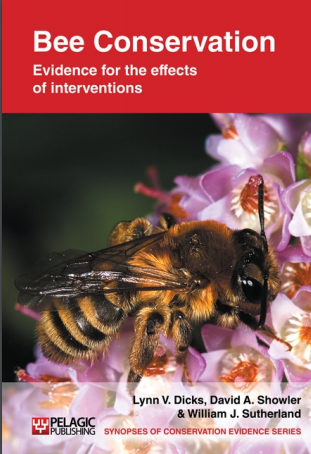Introduce agri-environment schemes to benefit wild bees
-
Overall effectiveness category Awaiting assessment
-
Number of studies: 5
View assessment score
Hide assessment score
How is the evidence assessed?
-
Effectiveness
not assessed -
Certainty
not assessed -
Harms
not assessed
Study locations
Supporting evidence from individual studies
In a replicated trial with 39 pairs of fields, Kleijn et al. (2001) found meadow bird agreements and/or botanical agreements, aimed at conserving wading birds and species-rich vegetation, respectively, in the Netherlands, enhanced the number of bee species relative to conventionally managed control fields. Bee diversity was very low in this study, sampled using 15-minute transect walks (not sweep nets). Three species, honey bee Apis mellifera, common carder bee Bombus pascuorum and buff-tailed bumblebee B. terrestris, accounted for 85% of bees recorded.
Study and other actions testedGoulson et al. (2002) compared the growth of experimental B. terrestris colonies placed on 10 farms with substantial conservation measures with those placed on 10 conventional arable farms. Conservation measures included conservation headlands, set-aside and minimal use of pesticides. This study found no measurable difference between colonies on the different types of farm. The authors suggest this is because B. terrestris has a foraging range that extends beyond individual farms, which may not be true for other bumblebee species.
Study and other actions testedKleijn & Sutherland (2003) reviewed studies of the effectiveness of European agri-environment schemes in published and unpublished literature. Three out of the 62 studies included bees. Two studies (Kleijn et al. 2001, reported above, and Allen et al. 2001) found more bees (more species of bee in the case of Kleijn et al. 2001) on agri-environment fields compared to control fields under certain schemes. The third study (Kleijn et al. 1999) is not reported to have found a difference in bee abundance or species richness between seven agri-environment fields and seven control fields.
Study and other actions testedA replicated controlled trial of agri-environment schemes on 21 pairs of fields in each of five European countries carried out in 2003 found significantly greater abundance and diversity of wild bees on fields managed under agri-environment schemes than on control fields in Germany and Switzerland, but no significant difference in the Netherlands, England or Spain (Kleijn et al. 2006). The agri-environment management options that benefited bees in this study were organic arable farming in Germany and Ecological Compensation Areas in Switzerland. Those that did not were meadow bird agreements in wet grassland in the Netherlands (bees sampled with sweep nets and transect walks), measures to protect steppe-living birds and compensation measures around Caballeros National Park in Spain, and 6 m wide grass field margin strips in England.
Study and other actions testedIn a replicated controlled trial involving 10 farms in east and central Scotland, Lye et al. (2009) compared numbers of nest-searching and foraging queen bumblebees Bombus spp. on land that had been managed under three different options of the Rural Stewardship Scheme (unsprayed grassy field margins, species-rich grassland and hedgerows) for three years with conventionally managed land of the same type. On farms with the agri-environment scheme, transects under the scheme attracted significantly more nest-searching and foraging queen bumblebees than conventionally managed transects. However, on conventionally managed transects, there was no significant difference between farms with and without agri-environment schemes in numbers of nest-searching queens, and conventionally managed farms had more foraging queens.
Study and other actions tested
Where has this evidence come from?
List of journals searched by synopsis
All the journals searched for all synopses
This Action forms part of the Action Synopsis:
Bee Conservation
Bee Conservation - Published 2010
Bee Synopsis





)_2023.JPG)














